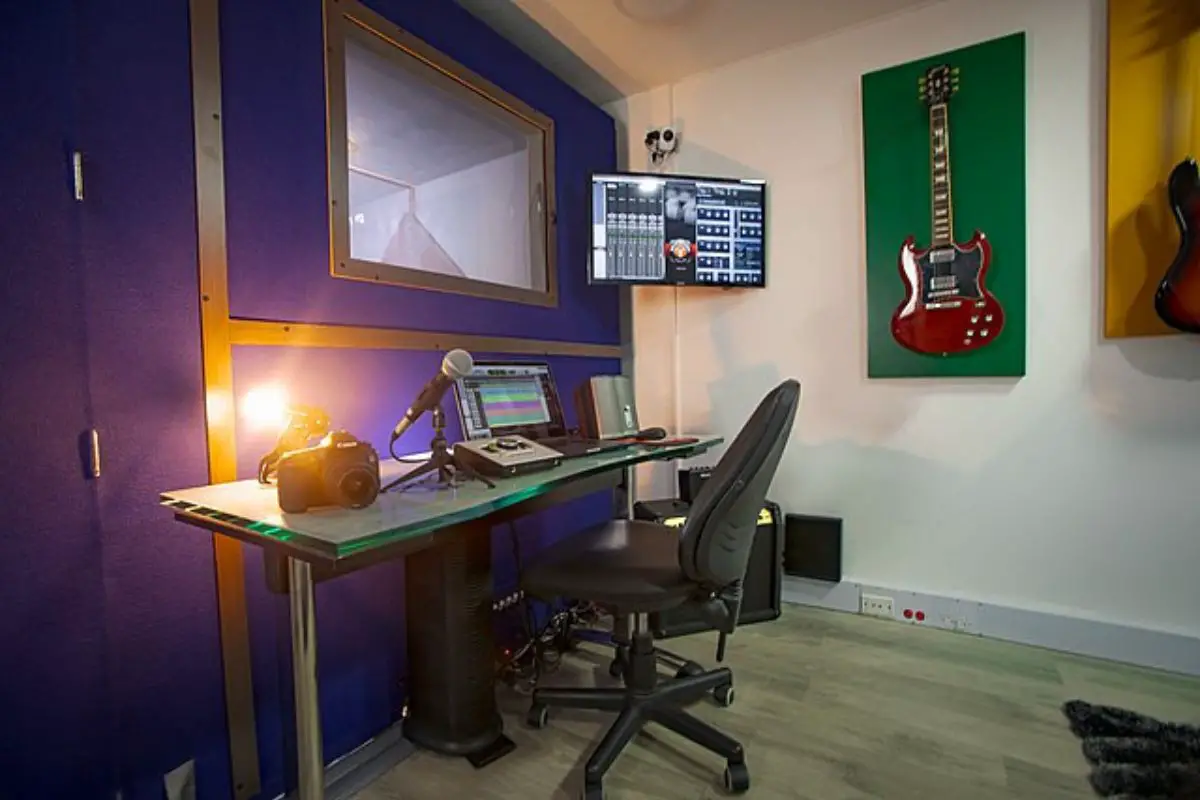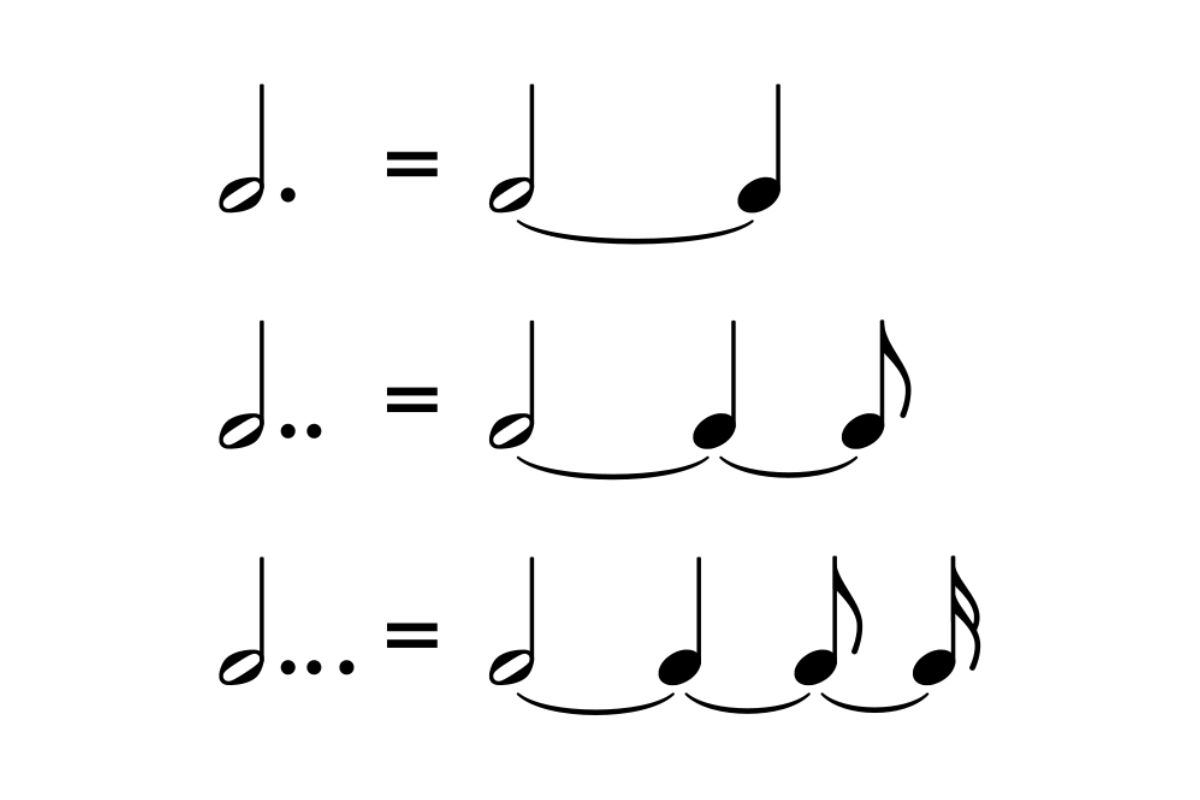When learning to read and play music, you may come across various symbols and notations that add complexity to the musical score. One such symbol is the dotted note, which is often seen alongside regular notes. You’ve seen them in music, but what exactly does a dot do to a note? How much does it change the length? Dive in as we unravel the secrets of dotted notes and discover their rhythmic impact!
What is a dotted note? A dotted note refers to a musical notation symbol consisting of a note with a dot placed next to it, indicating an increase in its duration by half of its original value.
What is a dotted note?
A dotted note is simply a musical notation with a dot to the right of the note head, as shown below. This dot extends the life of the note by adding half its value. Let’s have a look at some real-world instances to see how this works.

Types of dotted notes
We can add a dot to any note, which will have the same effect: it will make the note live longer by doubling its value. Let’s look at each sort of note and how adding a dot affects its duration.
- Dotted whole notes (Dotted semibreves): A semibreve, or entire note, is worth four beats. Nevertheless, if you make it a dotted semibreve, we double its duration. In the case of a whole note, the answer is 4 + 2 = 6 beats. Therefore, a dotted whole note is equivalent to combining whole and half notes.
- Dotted half notes (Dotted minims): A half note, often known as a minim, equals two beats. Yet, by making it a dotted half note, we increase its duration by half its value. In the case of a half note, 2 + 1 equals 3 beats.
- Dotted quarter notes (Dotted crotchets): A crotchet, often known as a quarter note, is equal to one beat. Nevertheless, when we make it a dotted crotchet, we double its duration. In the instance of a crotchet, it is 1 + ½ Equals 1 & ½ beats.
- Eighth notes with dots (Dotted Quavers): A quaver, or eighth note, is worth 12 beats. Yet, when we make it a dotted quaver, we double its duration. In the instance of a quiver, it is ½ + ¼ = ¾ beat.
- Dotted sixteenth notes (Dotted semiquavers): A sixteenth note, often known as a semiquaver, equals 1/4 of a beat. Nevertheless, we double its duration when we make it a dotted semiquaver. In the instance of a semiquaver, it is ¼ + ⅛ = ⅜.
To make things clearer, here’s a handy chart showcasing the effects of dots on note durations:
| Note Type | Note Duration | With Dot |
|---|---|---|
| Whole note | 4 beats | 6 beats |
| Half note | 2 beats | 3 beats |
| Quarter note | 1 beat | 1.5 beats |
| Eighth note | 0.5 beats | 0.75 beats |
AKAI Professional MPK Mini MK3

AKAI Professional MPK Mini MK3
How do dots change the length of a note?
When a dot is added to a note, its duration increases by half of its original value. For instance, a dotted half note is equivalent to a half note plus a quarter note, as the dot adds half of the value of the original note. Similarly, a dotted quarter note is equivalent to a quarter note plus an eighth note. The dot extends the note’s duration without altering the time signature or tempo of the music.
It’s important to note that multiple dots can be added to a note. Each dot increases the duration by half of the value of the last dot. This means that the lengthening effect accumulates with each additional dot. It’s also worth mentioning that the additional length provided by the dot affects both the written note and any tied notes that follow it.
This allows for greater rhythmic flexibility and complexity in music compositions. Dotted notes are used by composers to create rhythmic interest and variety, adding a distinctive feel to the music. Understanding how dots alter note lengths is crucial for accurately interpreting and performing music. It enables musicians to correctly execute the intended rhythm and maintain synchronization with other performers.
To further enhance your understanding, here are some dos and don’ts when working with dotted notes:
Dos:
- Experiment with dotted notes to create interesting rhythmic variations and syncopations.
- Combine dotted notes with other rhythmic elements to add complexity and excitement to your music.
- Utilize the concept of dots to create memorable melodic motifs that stick with the listener.
Don’ts:
- Overuse dotted notes excessively, as it may lead to rhythmic clutter and confusion.
- Neglect the other elements of music composition while focusing solely on dotted notes.
- Forget to experiment and push the boundaries of rhythm to discover unique musical possibilities.

How do two dots affect the duration of a note?
Double dots work similarly to single dots but with an added twist. Each dot adds half the value of the original note, just like before. However, with double dots, the second dot adds half the value of the first dot. This means that the duration is extended even further. Let’s unravel the mystery of double-dotted notes and understand how they alter the duration of a note.
Let’s explore some examples to see how two dots impact different note durations:
- Whole note with two dots: A whole note with two dots extends its duration significantly. The first dot adds half the value of the whole note (2 beats) to the original duration, resulting in 6 beats. The second dot adds half the value of the first dot (1 beat) to the duration, leading to a total duration of 7 beats.
- Half note with two dots: A half note with two dots also experiences an extended duration. The first dot adds half the value of the half note (1 beat) to the original duration, making it 3 beats. The second dot adds half the value of the first dot (0.5 beats) to the duration, resulting in a total duration of 3.5 beats.
- Quarter note with two dots: Applying two dots to a quarter note adds complexity to its duration. The first dot adds half the value of the quarter note (0.5 beats), extending it to 1.5 beats. The second dot adds half the value of the first dot (0.25 beats), resulting in a total duration of 1.75 beats.
Double-dotted notes introduce additional complexity and rhythmic interest to musical compositions. They allow for the creation of intricate and nuanced rhythms that capture the listener’s attention. By skillfully implementing double-dotted notes, you can elevate your music to new heights, creating captivating rhythms and engaging melodies.
They allow for the creation of intricate and nuanced rhythms that capture the listener’s attention.
The table below showcases the duration changes that occur when dots are added to different note types. Understanding these changes is essential for musicians, music producers, and audio engineers when working on compositions or recordings in a home studio.
| Note Type | Original Duration | Dotted Duration |
|---|---|---|
| Whole note | 4 beats | 6 beats (+50%) |
| Half note | 2 beats | 3 beats (+50%) |
| Quarter note | 1 beat | 1.5 beats (+50%) |
| Eighth note | 0.5 beats | 0.75 beats (+50%) |
What are the advantages and disadvantages of incorporating dotted notes?
Dotted notes offer various advantages and disadvantages when incorporated into musical compositions. Understanding these aspects can help musicians and producers make informed decisions regarding rhythmic choices and overall musical aesthetics.
Advantages
- Rhythmic variation: Dotted notes introduce rhythmic intricacies, adding interest and complexity to musical phrases.
- Syncopation and groove: By utilizing dotted notes, musicians can create syncopated patterns and grooves that enhance the overall feel and energy of the music.
- Expressive prolongation: Dotted notes allow for expressive prolongation of specific notes, emphasizing melodic elements or creating a sense of tension.
Disadvantages
- Complexity and precision: Working with dotted notes requires meticulous attention to rhythm and timing, as their durations differ from regular notes.
- Increased cognitive load: Incorporating dotted notes may introduce additional cognitive load for musicians, especially when performing complex rhythms or intricate musical passages.
- Potential rhythmic clutter: Excessive use of dotted notes without careful consideration may result in rhythmical clutter and a lack of clarity in the musical arrangement.
When utilizing dotted notes, it’s crucial to strike a balance and use them purposefully to enhance the overall musical expression while maintaining clarity and coherence within the composition.
If you want even more great tips and information, check out the video.
Frequently Asked Questions (FAQ)
Below are some of the commonly asked questions about dotted notes.
Can a note have more than two dots?
Yes, a note can have more than two dots. Each additional dot adds half the value of the previous dot to the note’s duration. However, it’s important to note that notes with more than two dots are less common and generally not frequently encountered in music compositions.
Can dotted notes be used in any style of music?
Absolutely! Dotted notes are a fundamental aspect of music notation and can be used in various styles and genres, ranging from classical to jazz, pop, rock, and beyond. The rhythmic versatility of dotted notes allows musicians to add flair, complexity, and expressiveness to their compositions across different musical styles.
Are dotted notes always played with a specific articulation or emphasis?
No, the articulation or emphasis applied to dotted notes depends on the musical context, the composer’s intent, and the performer’s interpretation. While dotted notes often receive a slight emphasis due to their extended duration, the specific articulation and emphasis vary based on the musical style, genre, and desired musical expression.
Conclusion
And that’s a wrap! We’ve explored the fascinating world of dotted notes, uncovering their impact on note durations and the rhythmic possibilities they bring to music compositions. Hopefully, you’re feeling more confident and inspired to incorporate dotted notes into your musical creations. Remember, with dots; you can add depth, groove, and complexity to your melodies, making your music stand out from the crowd.
Let me know your questions in the comments section below—I read and reply to every comment. If you found this article helpful, share it with a friend, and check out my full blog for more tips and tricks on music production, home recording studios, and audio engineering. Thanks for reading, and keep rocking to the rhythm of your beat!
Key takeaways
This article covered the topic of dotted notes, highlighting their impact on note durations and their versatility in music compositions. Here are some key takeaways:
- Dots added to notes extend their duration by half of the original note’s value.
- Dotted notes add rhythmic variation, syncopation, and expressive prolongation to music.
- Understanding the different effects of dots on various note types is crucial for precise rhythmical execution.
- Double-dotted notes further extend the duration, adding complexity to musical passages.
- Incorporating dotted notes requires careful consideration for balance and clarity within the composition.















